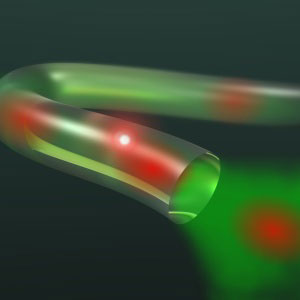| Oct 03, 2011 |
Quantum information: Glass finds its sparkle
|
|
(Nanowerk News) Quantum computers promise a whole new level of processing power, solving problems of greater complexity in a shorter timeframe than is possible with conventional machines. A crucial requirement of quantum computing, however, is a material that can combine the quantum systems at the heart of quantum information up to the scale of a workable device. Matthew Henderson and colleagues from the University of Adelaide and University of Melbourne in Australia have now produced just such a material by embedding nanoparticles of diamond in tellurite glass ("Diamond in Tellurite Glass: a New Medium for Quantum Information").
|
|
Classical computing is based on a language of ones and zeros, or bits. Quantum computers, on the other hand, use physical systems that are governed by the laws of quantum mechanics, dealing instead with quantum bits, or 'qubits'. Atomic-level defects in diamond are one such quantum system. "A defect in the carbon lattice comprising a nitrogen atom and an adjacent vacancy can act as a source of the single photons required for quantum information processing," explains Henderson.
|
 |
| A conception diagram of a tellurite glass optical fiber with embedded diamond nanoparticles as a source of single photons for quantum computing.
|
|
While diamond is fast developing as a useful material for quantum computing, significant challenges remain before it can be scaled up for practical applications. Henderson and his colleagues examined an alternative route to scaling up these qubits by embedding optically active diamond nanocrystals in a conventional optical medium — tellurite glass, which absorbs little light at the wavelengths generated by the diamond defects.
|
|
The researchers fabricated their system by adding diamond particles 40–50 nm in diameter to molten tellurite at 700 °C. They then drew the diamond-bearing tellurite glass out into optical fibers of as narrow as 160 µm in diameter (see image). The team confirmed that the embedded nanoparticles could still generate single photons even after this drawing process.
|
|
The approach taken by Henderson and his team is radically different from previous attempts to combine diamond with optical materials. For example, diamond nanocrystals have been attached to the outside of optical fibers in the past. The drawn fibers, however, have exciting potential for integration into microstructured optical fiber systems and optical cavities. Embedding the light source also leads to stronger coupling between qubits and the optical field. "The ultimate aim is an efficient fiber-based single-photon source," says Henderson.
|

